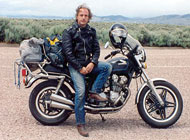Checklist for Scooter Friendliness: How Does Your City Stack Up?
Thursday, September 5th, 2013This is a guest post provided by Amy Moczynski.
With two-wheeled transportation becoming more popular because of gas prices, more people are making scooters and motorcycles their primary form of transportation. Bicycles or walking might be the preferred way of transportation in cities that allow for it, but the majority of people will need some form of motorized vehicle to get them from point A to point B. With most scooters offering nearly 70 miles per gallon, scooters not only help you save on gas but also help lower your carbon footprint.
If you’re considering switching to a scooter as your primary mode of transportation, there are some things to consider before making the switch. Aside from making sure you have the proper license and training to ride said scooter, you should consider how scooter friendly your city is before making the switch full time.
For anyone unsure of how to determine how scooter friendly a city is, here are some considerations to keep in mind.
Scooter Repair and Retail
Just like any automobile, you’ll need to take your scooter in for periodic tune ups. You’ll also need to make sure you purchase any gear before hitting the road (a helmet is a must, and you might want to trick out your scooter with some sweet swag). Consider how close you are to repair shops and retailers so you know where to turn if you need something last minute. For example, the website for Bintelli scooters has a store locator so you can see if your scooter’s retailer has a nearby location.
Parking and Storage
Parking might seem like a breeze if you own a scooter (it’s small, so it can fit anywhere, right?), but in certain cities, there isn’t dedicated parking for scooters. Instead, scooters have to use regular size parking spaces, and that often means they need to purchase parking decals also meant for full-size automobiles, so there’s no cost savings involved.
Something to consider is the number of (or presence of) parking devoted just to scooters or motorcycles. San Francisco, Seattle, Philadelphia, and Cincinnati are several cities that have created special parking areas just for scooters, and the mayor of Boston has designated free parking for scooters and motorcycles, offering scooter owners in this city an added benefit of scooting as opposed to driving.
You’ll also want to consider where you will store your scooter, both overnight and during the seasons you won’t be driving it. Is the area you live safe enough to leave your scooter outside overnight? Do you need to park it in a garage like a car? If you need to park it in a garage, that’s an extra expense to consider.
Weather
If you live in an area with consistent rain throughout the year, you might be less inclined to purchase a scooter. The same goes for areas that have several months of snow and ice in the winter, or places with pretty steep inclines and rough terrain. While that’s not to say you can’t enjoy your scooter in the warmer seasons like spring and summer, consider how much use you’ll get from it throughout the year before deciding to purchase. Clear, sunny days are made for scooting, so make sure your city offers plenty of ways you can take advantage of the climate.
Also make sure you know how to ride your scooter in not so favorable conditions. If you live in a location that is prone to sudden downpours, you might not have the option of only traveling when it’s clear and sunny. Make sure you feel confident enough driving through these conditions when needed.
Incentives
Are there incentives for owning a scooter in your city? For example, Austin Energy offers $50 to $300 incentives for people who use two-wheeled electric vehicles. See if your town offers any sort of credit or rebates when you switch to a greener form of transportation.
Recent from National Motorcycle Examiner
Another day going separate ways from the OFMC
Biker Quote for Today
Speed bumps never seem to make me go any faster.

